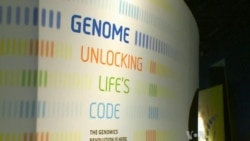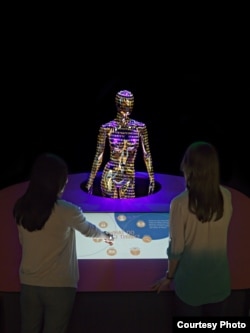A genomic revolution is changing people’s lives. A new exhibit at the Smithsonian’s National Museum of Natural History in Washington explores the extraordinary impact it is having on science, medicine and nature.
"Genome: Unlocking Life’s Code" opened to large crowds seeking to learn more about the field. The exhibit marks two scientific milestones: The 10th anniversary of the completion of the human genome project, the first blueprint of the human body, and the 60th anniversary of the discovery of DNA’s double helix structure which laid the foundation for understanding how our genetic information is encoded and copied.
"I have always found it really intriguing that everything about who we are and what we look like is controlled by these tiny molecules called DNA," said Ben Thomas, 12, who came with his family from Dayton, Ohio excited to embark on a genomic journey. "This exhibit is like cake to me. I love this stuff."
Multimedia story-telling
The four chemicals that make up the fabric of our being are on display in a mesmerizing variety of ways throughout the exhibit: from photographs of faces highlighting genetic differences to an endless scroll of the letters representing them in our genome - A,G,C and T - on a huge TV screen.
Those same letters are projected in eye-popping orange on a mannequin nicknamed Gigi, says exhibit developer Meg Rivers.
“She has on her the human genetic code and she is meant really to engage visitors and get them to think about having their own code and what does it means to them,” she said.
Rivers says visitors get that chance thanks to 3D models, animated videos, personal stories, touch screen panels, interactive games and genetic sequencing equipment.
“You are able to go into these different alcoves, looking at personalized medicine, exploring medical mysteries," she said. "What does it mean to your health, the ethnical, legal and social implications that people are now starting to come across in the media, looking at our ancient ancestry up to today and what genomic science means to our natural world, our understanding it, our environment.”
Genomic literacy
But genomic science is not static. A scrolling news line keeps visitors up-to-date on the latest medical breakthroughs.
Eric Green is director of the National Human Genome Research Institute, which collaborated with the Smithsonian to create the exhibit. He says the overall aim is to raise genomic literacy.
“By the end of this decade, genomics will become very much part of medical care in areas like cancer, in areas like infectious disease, in areas like deciding which medications to give people, in areas related to rare diseases that have genetic cause," he said. "This is going to become part of the language of medical care and people are going to need to become familiar with it.”
Genes in a bottle
For 12-year-old Kellen Alfaro that immersion starts immediately as she joins her classmates from Meridian Public Charter School in Washington in a hands-on activity to capture DNA from cheek cells.
Those cells are transferred from her saliva into a tube that has a solution that makes DNA visible. The tiny white threads are Kellen’s DNA, which she pours into a tiny bottle that becomes a pendant for a necklace.
She says she’ll wear her DNA all the time.
“It defines me. And it tells me who I am and where I come from,” she said.
Her teacher Andrea Conway says the outing makes the science real.
“This helps us in the classroom because it not only gives students an opportunity to be excited about what we’re learning, but it helps us to actually make connections to different things that we learned about before in terms of human life, plants and animals,” she said.
Seven-and-a-half million people visit the National Museum of Natural History each year. They will have a chance to unlock life’s code for themselves through September.
"Genome: Unlocking Life’s Code" opened to large crowds seeking to learn more about the field. The exhibit marks two scientific milestones: The 10th anniversary of the completion of the human genome project, the first blueprint of the human body, and the 60th anniversary of the discovery of DNA’s double helix structure which laid the foundation for understanding how our genetic information is encoded and copied.
"I have always found it really intriguing that everything about who we are and what we look like is controlled by these tiny molecules called DNA," said Ben Thomas, 12, who came with his family from Dayton, Ohio excited to embark on a genomic journey. "This exhibit is like cake to me. I love this stuff."
Multimedia story-telling
The four chemicals that make up the fabric of our being are on display in a mesmerizing variety of ways throughout the exhibit: from photographs of faces highlighting genetic differences to an endless scroll of the letters representing them in our genome - A,G,C and T - on a huge TV screen.
Those same letters are projected in eye-popping orange on a mannequin nicknamed Gigi, says exhibit developer Meg Rivers.
“She has on her the human genetic code and she is meant really to engage visitors and get them to think about having their own code and what does it means to them,” she said.
Rivers says visitors get that chance thanks to 3D models, animated videos, personal stories, touch screen panels, interactive games and genetic sequencing equipment.
“You are able to go into these different alcoves, looking at personalized medicine, exploring medical mysteries," she said. "What does it mean to your health, the ethnical, legal and social implications that people are now starting to come across in the media, looking at our ancient ancestry up to today and what genomic science means to our natural world, our understanding it, our environment.”
Genomic literacy
But genomic science is not static. A scrolling news line keeps visitors up-to-date on the latest medical breakthroughs.
Eric Green is director of the National Human Genome Research Institute, which collaborated with the Smithsonian to create the exhibit. He says the overall aim is to raise genomic literacy.
“By the end of this decade, genomics will become very much part of medical care in areas like cancer, in areas like infectious disease, in areas like deciding which medications to give people, in areas related to rare diseases that have genetic cause," he said. "This is going to become part of the language of medical care and people are going to need to become familiar with it.”
Genes in a bottle
For 12-year-old Kellen Alfaro that immersion starts immediately as she joins her classmates from Meridian Public Charter School in Washington in a hands-on activity to capture DNA from cheek cells.
Those cells are transferred from her saliva into a tube that has a solution that makes DNA visible. The tiny white threads are Kellen’s DNA, which she pours into a tiny bottle that becomes a pendant for a necklace.
She says she’ll wear her DNA all the time.
“It defines me. And it tells me who I am and where I come from,” she said.
Her teacher Andrea Conway says the outing makes the science real.
“This helps us in the classroom because it not only gives students an opportunity to be excited about what we’re learning, but it helps us to actually make connections to different things that we learned about before in terms of human life, plants and animals,” she said.
Seven-and-a-half million people visit the National Museum of Natural History each year. They will have a chance to unlock life’s code for themselves through September.













